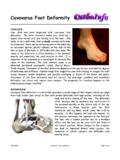Transcription of PI - Hip Iliac Apophysitis
1 orthoinfo Iliac Apophysitis Page 1 of 3 Iliac Apophysitis INTRODUCTION You have been diagnosed with Iliac Apophysitis . This is a mechanical overloading injury at the tendons that originate at the front of the pelvis above the hip. This may also be referred to as an avulsion fracture or tendonitis of the anterior thigh muscles. The pain improves with rest and symptomatic treatment. BACKGROUND Iliac Apophysitis is one form of several apophyseal injuries, which can occur in skeletally immature patients between the ages of 12 and 18. An "apophysis" is the anatomic term used to describe a cartilage growth area on a bone where there is a muscle attachment to the bone. Apophysitis is the term used to describe an acute or chronic traction injury at the tendon insertion site.
2 There are several attachment sites on the pelvis for strong tendons which can injured, aggravated, or avulsed (pulled off). The most common locations include the anterior superior Iliac spine, the anterior inferior Iliac spine, the ischial tuberosity, the Iliac crest apophysis, and the lesser trochanter apophysis. Aggravation or avulsion of the anterior superior Iliac spine (ASIS) occurs with a sudden contraction of the sartorius when the hip is extended with the knee flexed. On examination, localized tenderness and swelling is noted and flexion and abduction of the thigh provokes symptoms. Xrays may show, displacement of the ASIS but marked displacement is rare. Avulsion of the anterior inferior Iliac spine (AIIS) occurs after contraction of the rectus femoris with vigorous kicking.
3 Examination reveals local tenderness and swelling in the region of the AIIS and exacerbation with active flexion. Xrays may demonstrate mild displacement of the AIIS. The ischial apophysis is the site of the hamstring and adductor magnus origin, and it is the last apophysis to unite, usually at age 25. The mechanism of injury is a vigorous hamstring contraction with the hip flexed and the knee extended. In runners, this injury occurs most often in hurdlers. The athlete complains of pain at the ischial tuberosity and difficulty sitting. Gait may be antalgic. On examination, hip flexion with the knee extended will reproduce symptoms; thus, the presentation and examination are similar to a hamstring strain in an adult. Radiographs may demonstrate a displaced fragment and displacement greater than 2 cm may require surgical fixation.
4 Although initial treatment is usually symptomatic as described below, poor healing or orthoinfo Iliac Apophysitis Page 2 of 3 other complications are more frequent. In addition, time away from sports is often longer than that of other apophyseal avulsion injuries Acute avulsion of the Iliac crest apophysis in a runner occurs with the sudden contraction of the abdominal musculature that is opposed by simultaneous contraction of the gluteus medius and tensor fascia latae. This may result from excessive arm swing and trunk rotation while running and may occur with a sudden change in direction. On examination, symptoms are reproduced with resisted abduction of the ipsilateral side and palpation of the Iliac crest. Oblique radiographs will reveal an avulsion of the Iliac crest.
5 Avulsion of the lesser trochanter apophysis may occur with sudden contraction of the iliopsoas. The athlete experiences a sudden onset of anteromedial hip pain while running. On examination, passive internal and external rotation and active hip flexion reproduce symptoms. Gait is antalgic. Radiographs demonstrate an avulsion of the lesser trochanter. CLINICAL PRESENTATION AND DIAGNOSIS Pain may start suddenly during a demanding activity or sport or it may have a gradual onset of pain with no clear history of injury. Examination reveals tenderness to palpation at the musculotendinous insertion into bone. An apophyseal avulsion fracture is usually acute, and the displaced fragment may be bony or cartilaginous. The mechanism of injury is an excessive force from a strong or violent muscle contraction that occurs across an apophysis.
6 The usual symptom of an apophyseal avulsion fracture is a sudden onset of pain, swelling, and weakness. Generally, there is no history of direct trauma. Radiographs will confirm the diagnosis, and comparison views of the contralateral side may be helpful. TREATMENT Treatment progresses through several phases. Treatment starts with rest and protection to limit muscle spasm. Once acute pain has partially improved, it is beneficial to start gentle stretching. As the pain and motion continues to improve, progressive resistive exercises. In the longer term, continued participation with a focused flexibility and strengthening program are important for full recovery of normal usage and control.
7 Most of these injuries are managed conservatively, and indications for surgical fixation are exceedingly rare. orthoinfo Iliac Apophysitis Page 3 of 3 The initial phase of treatment is with avoidance of aggravating activity and symptom control. Rest, limited activity, and use of crutches are the primary means of reducing pain and promoting healing. Ice and medication are used as needed. The second phase of treatment focuses on gentle stretching to recover motion. As pain improves, light duty activity is allowed, but running and aggravating activities are still avoided. As pain improves, strengthening and proprioceptive is added to the physical therapy program. Finally, sport specific drills and a gradaul return to full activities is allowed.
8 Premature return to sports before complete healing will result in re-injury. EXPECTED OUTCOME AND COMPLICATIONS Overall prognosis is good, but healing time may be slow. Returning to exercise or sports too early can lead to a recurrent injury and slower healing. MORE INFORMATION Further information can be obtained on the internet. Your local public library can help you explore these sources if you are interested. Two good sites for expert and peer reviewed information are the American Academy of Orthopedic Surgeons at and FEEDBACK If you have questions or comments, please contact the office or submit them to the web site at


